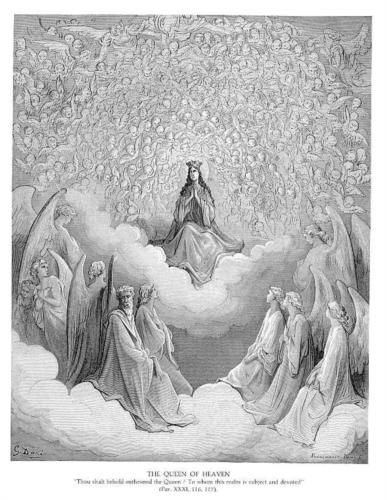Canto
XXXI
In
the Empyrean, Dante (the character) surveys what is around him now that his
eyes have been fully opened. He sees the
heavenly structure before him that is in the shape of a white rose. This is the Empyrean and it is filled with all
the blessed souls in paradise. He sees
angels flying around, going back and forth from the center point, which is God,
to the flowers, who are the souls sitting inside the white rose. He is so awestruck he feels like a barbarian
who has lived in huts stepping into the glory of the city of Rome for the first
time. He stares into the rose and for
the first time since coming to paradise can see clear faces, other than that of
Beatrice. He turns to ask Beatrice some
questions but finds that she is gone and in her place is a kindly, old man who later
we learn is St. Bernard of Clairvaux.
Bernard tells Dante to look at the third to last row of the rose and
there he can see the beautiful face of Beatrice who has taken her assigned
heavenly seat. Though the distance may
be hundreds of miles away, Dante can clearly see her face as if it were close
by. Realizing that his time with
Beatrice is over, he says a prayer of homage and gratitude to her for saving
his soul. She smiles back in
acknowledgement that she has heard his prayer.
Bernard instructs Dante to now focus on the Queen of heaven if he wishes
to experience the complete divine vision.
Looking up Dante sees the brightest face of the Empyrean, the Blessed
Virgin, shining like the sun and with a host of angels dancing about her,
bringing pleasure to all the other souls.
Dante and Bernard stare at the Virgin Mother in fixed mystical gaze.
Canto
XXXII
At
the Empyrean, St. Bernard describes to Dante the structure of the rose and
points out several of the inhabitants, using Mary as the frame of
reference. Sitting below the Blessed
Mother is Eve, and below Eve is Rachel.
To Rachel's right across the dividing line that separates the
pre-Christian and post-Christian souls is Beatrice. Below Rachel in successive rows are Sarah,
Rebecca, and Ruth. These women form a
wall that separates those that believed in the coming messiah (the Old
Testament Jews) from those that believed in Christ that is the messiah. Bernard points out that the Old Testament
half is filled while the Christian half, which has the same number of seating,
is unfilled and to be filled. Directly
across the Virgin Mother on the Christian side is St. John the Baptist. In subsequent rows below him are Francis,
Benedict, and Augustine. This is the
upper half of the rose. In the lower
half reside a multitude of saved babies, children that were too young to commit
willful sins. These children are divided
into three categories: the Jewish
infants before circumcision was instituted, the Jewish infants who are
circumcised, and the Christian infants that are baptized. Unbaptized children who don't fit these
categories are in Limbo. Bernard
redirects Dante's gaze back "to the face that most resembles Christ,"
Mary. The angel Gabriel has come singing
the Ave Maria to her. Bernard continues
to point out more of the blessed: Adam, St. Peter, St. John the Evangelist,
Moses, St. Anne, and St. Lucy. Finally
Bernard tells Dante it is time to seek the complete vision of God and the only
way to do it is to pray to Mary for such a grace. Bernard will start the prayer but asks Dante
to join his heart to it.
Canto
XXXIII
Continuing
from where the previous canto ended, St. Bernard offers a prayer to the Virgin
Mother to grant Dante the complete vision of God. He starts by paying homage to the Blessed
Mother, a lady both humble and exalted who through her acceptance of God's will
changed human history. Bernard continues
by citing her virtues, kindness, compassionate, munificent. He appeals to her on Dante's behalf to grant
him the most blessed theophany which no living person has ever seen. He begs her to use her prayers for him, not
only to see God but to preserve his purity after the vision and protect him from
his mortal inclinations. He further
implores that Beatrice and other souls in the rose are joining him in this
prayer. Mary's eyes, which are fixed on
Bernard, signal her appreciation, and then turn toward the center light. Dante, staring upward, feels his sight grow
purer and sharper, penetrating the exalted light of God. What he sees he cannot now articulate, and
stepping out of the narrative appeals to God to recall what he saw so that now
he can express it. He now recalls that
his sight merged with the "goodness that is infinite" and felt the
love that unifies the differed elements of the universe. At that moment, in a flash, Dante understands
"the universal form" that unites all disparate, knotted things. What he sees are three overlaying circles of
different colors, yet fused into one. As
if from the colors themselves and within the circles, the face of Christ
suddenly appears, and in a moment as instant as lightning, the vision
disappears.


No comments:
Post a Comment